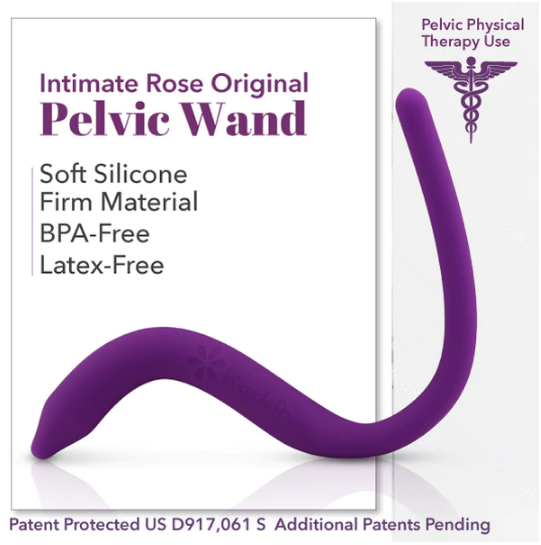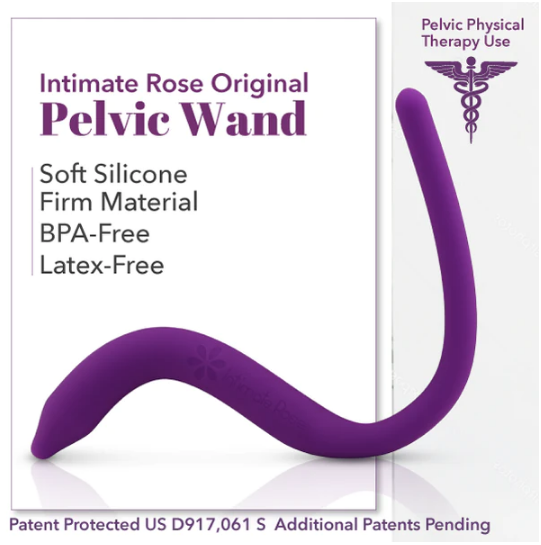7 Sneaky Symptoms of Pelvic Floor Tightness You Didn’t Know You Had
Lately, a lot of women have contacted me about what to do about a tight pelvic floor. Which means there’s increasing awareness that pelvic floor tightness is even a thing vs. the previous “everyone should do Kegels” (or “no more Kegels”) mentality.
So how can you tell you have a tight pelvic floor? Why does it matter? And what can you do about it?
In this post, I'm sharing all about pelvic floor tightness including:
A Too Tight Pelvic Floor? What It Is and Why It Matters
7 Sneaky Symptoms of Pelvic Floor Tightness You Probably Didn’t Know About
How to Balance (not just stretch or strengthen) Pelvic Floor Muscles So They Work FOR You, Not Against You
Final Thoughts on Pelvic Floor Tightness + Free Printable
So now I bet you’re curious if maybe you might have a tight pelvic floor…Keep on reading.
Want to learn how to release your tight pelvic floor muscles? Grab my Insider Guide to Pelvic Health!
And be sure to pair it with this Pelvic Wand from Intimate Rose ($5 off with link!).
A Too Tight Pelvic Floor? What It Is and Why It Matters.
A few years ago, Kegel exercises were all the rage and touted as the “cure-all” for all things pelvic floor.
Leaking urine? Do Kegels.
Want to have a better birth? Try more Kegels.
Want to tone up “down there” and improve intimacy? Kegels.
But what about? Kegels! Always Kegels!
It reminds me of this birthday card I got once that went something like this…
You can do it at a stoplight
While driving in your car
When you’re about to go to sleep at night
Lying in the dark
You can do it in the shower
Or shopping at the store
Yes, you can do your Kegels, anywhere you are!
(And no one will ever know. He-he!)
Okay, I don’t exactly remember what the birthday card said, and it was about having birthdays, not doing Kegels, but I think you get the point.
Kegels have been trending as the go-to exercise to treat every pelvic floor issue under the sun (or pants, as it were), but it’s just a really an oversimplified way of brushing off addressing pelvic floor struggles. I mean, if your elbow hurts, I’m not going to tell you to go squeeze a stress ball 50x/day and that will take care of it. (To be fair, that might be part of the early phase of treatment, but certainly not all of it.)
So what does this Kegels craze have to do with too tight pelvic floor muscles? Well, not everything, but almost. Unfortunately the Kegel craze ingrained the (wrong) idea that if we’re having pelvic floor issues it must mean the pelvic floor isn’t squeezing hard enough, long enough, or just enough enough. That idea, coupled with increased stress and tension overall which oftentimes translates to the pelvic floor, leads to a LOT of the same shortened (aka tightened) muscle position almost constantly.
Try this!
Make a fist and squeeze as tight as you can. Oh, but that’s not tight enough. Squeeze even tighter. Now tighter. And tighter still. Pretty much those last several cues of “squeeze tighter” did nothing right? Because you were already squeezing as tightly as you could. So there wasn’t any point in telling you squeeze tighter.
So how do you strengthen a muscle that’s already squeezed? Well, first you have to release it. But what if it’s been in that tightened position so long it can no longer relax? Ah, and herein lies the problem.
If our muscles are in a chronic state of tension, they’ve lost the ability to lengthen properly. Hence the slew of people who don’t actually get better with Kegels and are desperate for solutions.
On the flip side, more and more women are becoming aware that pelvic floor tightness is a “thing” and are reaching out for help. Yay! I’m so happy that the awareness is growing that there’s something you can do about pelvic issues just as much as any other health concern.
But how do you know if your pelvic floor is tight? Check it out…
7 Sneaky Symptoms of Pelvic Floor Tightness You Probably Didn’t Know About
You make noise when you pass gas. Wait. What?! Yeah, I’m talking about breaking wind, cutting the cheese, pooting, farting, tooting, or whatever you want to call them. Loud ones.
Or maybe not loud, per se, but they definitely make a sound. Like this one time when I was a teenager and my brother and I were walking down the hall to our rooms. And then I pooted. Except it didn’t sound like the usual breaking of wind. It sounded like someone whistled. Seriously.
My brother turned around to look behind us, then looked at me with a really weird expression on his face and said, “What was THAT?”
“I pooted,” I sheepishly grinned.
And then we busted out laughing! But truly, if I hadn’t known I’d done it, I would have thought someone behind us had whistled too.
Now please tell me how this happened. Do you think my pelvic muscles were nice and relaxed? Um. No! I was squeezing for all I was worth to try to keep from passing gas in front of my brother. And instead it cam out as a whistle!
So, of course there will be times when we don’t want to pass gas and tighten those muscles. But do you have the ability to pass gas without any sound? As in, are you physically able to relax your muscles enough to let gas pass silently? Or does it always come out with sound? Give it a try the next time you’re passing gas. You’re welcome!You tend to clench your jaw or have tight neck muscles. Everyone pretty much knows these are signs of tension. And if you have these symptoms, chances are pretty good that you’re going to have some pelvic floor muscle tightness too. A big ole dose of de-stress is a great place to start. Cue the Epsom salt bath with a bit of lavender, some deep breathing, and gratitude journaling for starters.
You have foot pain or soreness (or wear high heels a lot). Oh my. The impact foot health has on the pelvic floor is substantial. Foot pain and pelvic floor tightness go hand-in-hand. And if you’re wearing heeled shoes, the pelvic floor muscles are automatically in a shortened position. Oh, and flip-flops? Yeah, that toe-gripping habit increases pelvic floor tightness too.
You’re constipated. While gut health absolutely impacts constipation, the pelvic floor plays no small role in it as well. So if you’re constipated, in addition to eating all the ground flax seed, drinking plenty of water, and eating lots of fruits and veggies, better check in with that pelvic floor and make sure it is able to relax to let things through when the time comes.
You leak urine or poo. Okay, hold the phone. Doesn’t it seem like this would mean your pelvic floor isn’t tight enough? But remember that if something is already squeezed you can’t squeeze it more. And you’ll start to notice that you’re actually holding tension in an effort to keep from leaking…but it’s not working. Time to lengthen so you can strengthen!
You have pain with penetration during intercourse or insertion of a menstrual cup or tampon. Or maybe these things aren’t even a possibility at all due to tension or pain. This one’s a pretty classic symptom of tightness.
You have hip pain or tailbone pain. While these aren’t a sure-fire sign that you have pelvic floor tightness, it’s more likely than not as they often show up together.
Actually, any type of pain or symptoms around the abdomen and pelvic girdle will affect your pelvic floor. Low back or sacroiliac joint (SIJ) pain, pubic symphysis dysfunction, IBS, interstitial cystitis, chronic UTI’s, diastasis recti, or pubic bone pain. Everything is so interrelated that checking in with the pelvic floor is a must with any of these issues. It could be a key component for pain resolution.
Bonus symptom: You had perineal tearing during childbirth. Perhaps this was related to a tight pelvic floor that couldn’t stretch well during birth…hard to say in hindsight - but stands to reason that tight pelvic floor muscles aren’t going to be as flexible. Even if we can’t say for sure a tight pelvic floor was the cause of perineal tearing, if you did tear, you for sure have scar tissue from the wound. And your muscles and perineum aren’t going to be as flexible now that there is a bit of scarring.
So whether or not a tight pelvic floor is related to the amount of perineal tearing that occurs, perineal tearing/episiotomy (and repair) certainly can cause a tight pelvic floor. See, normal tissue lays down its fibers all neat and orderly-like. But scar tissue lays down fibers every which way making it thickened and tight. Not stretchy.
If you had pelvic floor tightness before birth or not, addressing scar tissue after any type of tearing, episiotomy, or surgery is a must!
How to Balance (not just stretch or strengthen) Pelvic Floor Muscles So They Work FOR You, Not Against You
So here’s where the trend has made a complete 180, and now instead of everyone thinking they need to be doing Kegels, I’m hearing a lot of women thinking they have a tight pelvic floor and need to stretch.
But let’s not lean so far into that way of thinking that we are missing what’s actually going on with the pelvic floor muscles. First, let’s ask the question, Why are the pelvic floor muscles tight? Are they tight as a response to pain? Postures? Stress? Injury?
See, if you jump in with the same attitude as the Kegels craze of “let’s Kegel for everything!” But now it’s, “Let’s release all the tight muscles,” what are you left with? Instability, that’s what.
The body is not dumb. And it’s definitely not working against you! So if you have tight pelvic floor muscles, the key to helping them release is to work on the areas around the pelvis. To make sure everything is balanced and stable. And that your pelvic floor muscles aren’t compensating for a weakness elsewhere.
While working on those muscles, it can be super helpful to use a pelvic wand to help release any trigger points and bring immediate relief! I highly recommend this one from Intimate Rose (get $5 off with my affiliate link).
Next, work on strengthening to lengthen, not just general stretches and release work. While those have their place and can be a nice pain-relief strategy, the bread and butter is in strengthening the antagonist (the guy who works in opposition) to the muscle that is tight which will help to both release the tightness and restore balance between the muscles.
You also need to take a look at the “why” behind what’s contributing to the tightness. If it’s stress - address it. If it’s from sitting all day, take lots of walking breaks or consider a sit-to-stand workstation setup, sitting in a variety of positions, sitting on a ball instead of a chair, etc.
If it’s due to injury, do all the things to encourage good healing of the tissues through gentle rehab of the tissues themselves but also by supporting your overall health so your body can do its job and heal things well. Great nutrition, hydration, joy, gentle movement, fresh air, sunlight, and stress management are all keys to helping your body be able to heal well.
Final Thoughts on Pelvic Floor Tightness
Pelvic floor tightness is definitely a thing. And probably much more prevalent than we realize. If you’ve got any of these 7(+1) symptoms of pelvic floor tightness, don’t ignore it, but do consider it as part of the larger solution to whatever other symptoms you’re having. Always remember that the body all works together so what affects one area will affect other areas as well.
Choose one good habit to work on, like exercising, getting good rest, drinking more water (and only water), daily devotionals, getting outside more, helping others, etc., and just see how that affects your overall health including your pelvic floor. And prepare to be amazed!
Need more targeted strategies?
Grab the Complete Pelvic Health Bundle for the best strategies for pelvic health for life!
You might also find these interesting…
A few of my fave whole food vitamins, minerals, antioxidants, and plant-based protein for power-packed nutrition.
Chewables for kids (or adults!). Get these free for your kids ages 4-25 with every adult order. Woot!
Note: For educational purposes only. Not to take the place of or be taken as medical advice.
*This post may contain affiliate links to some or all of the products listed. While it will not change the cost to you, I may receive compensation if you choose to purchase through my links. Thank you for your support.










